Double Seed Stitch Scarf
Maybe if you live in Cairo, a camel is not so uncommon a thing, but for New Yorkers your best chance of getting close to a camel is at the zoo… Or at Purl Soho! Our new Camel yarn from Lanecardate is 100% camel and 100% special.
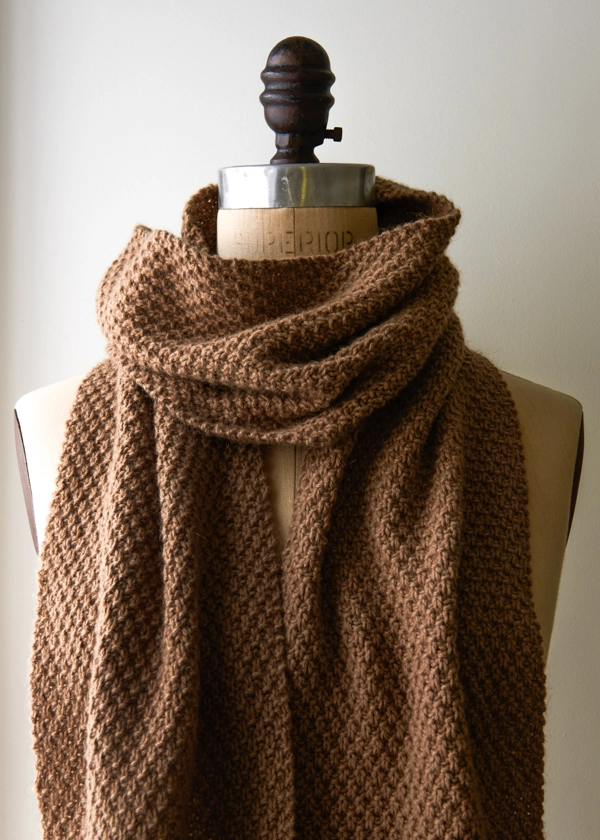
This Camel yarn has a lofty chainette construction, which makes it especially toasty and also lends itself to pretty stitch patterns, like the one we used in our stunning Double Seed Stitch Scarf. In the only color nature intended, camel, this scarf’s rich color and beautiful texture make it a true classic.
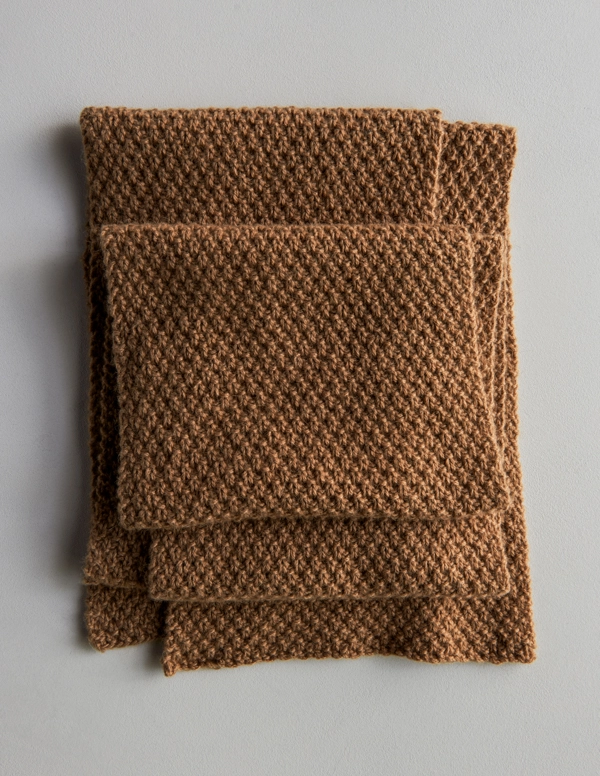
Fine camel yarn comes from the animals’ downy inner coats, which are as soft and warm as cashmere. And so, although we love the fun of trying this off-the-beaten-path fiber, even more, we love its softness, beauty, and intrinsic warmth. Thank you, camels! -Laura
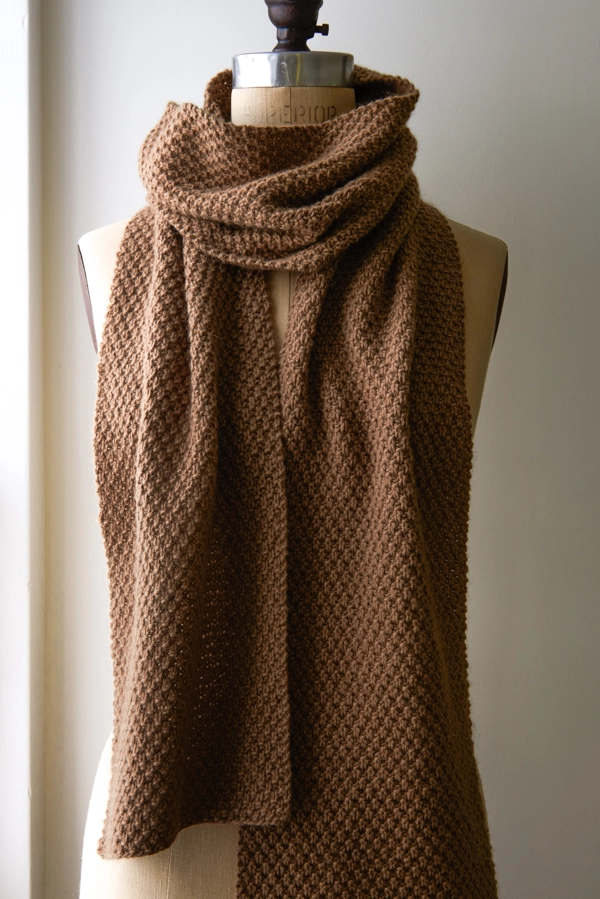
Update: Our Double Seed Stitch Scarf In Serpentina!
September 30, 2019
Manos del Uruguay’s Serpentina is equally beautiful and festive! We used three skeins of the color Georgia for our classic Double Seed Stitch Scarf. You’ll need the same US 8 needles as well as the pattern as written above. Simply knit as written until the piece measures 78 inches from the cast-on edge before binding off. Lovely!

Designed by Purl Soho designer, Laura Ferguson.
Share your progress and connect with the community by tagging your pics with #PurlSoho, #PurlSohoBusyHands, and #PurlSohoDoubleSeedStitchScarf. We can’t wait to see what you make!
Materials
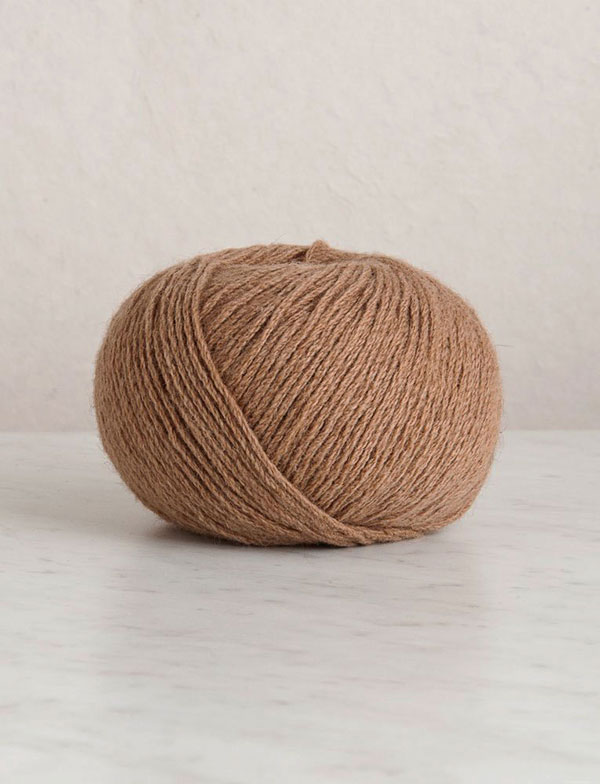
- 5 skeins of Lanecardate’s Camel, 100% camel; approximately 680 yards required.
PLEASE NOTE: Lanecardate Camel is no longer available for purchase. To browse our full offerings for Light Worsted/DK Weight yarns, click here, or you could also use…
- 3 skeins of Manos del Uruguay Serpentina, 100% Superwash Merino Wool.
You’ll also need…
- US 8 straight or circular needles
Gauge
19 stitches = 4 inches in stitch pattern
Size
Finished Dimensions: 9½ inches wide x 78 inches long
Pattern
Cast on 45 stitches. We used a basic Long Tail Cast On.
Row 1: K1, *p1, k1, repeat from * to end of row.
Row 2: Repeat Row 1.
Row 3: K2, *p1, k1 repeat from * to last stitch, k1.
Row 4: Repeat Row 3.
Repeat Rows 1-4 until piece measures approximately 78 inches from cast-on edge, ending with Row 3.
On the next row, bind off in pattern.
Weave in your ends and block as desired.
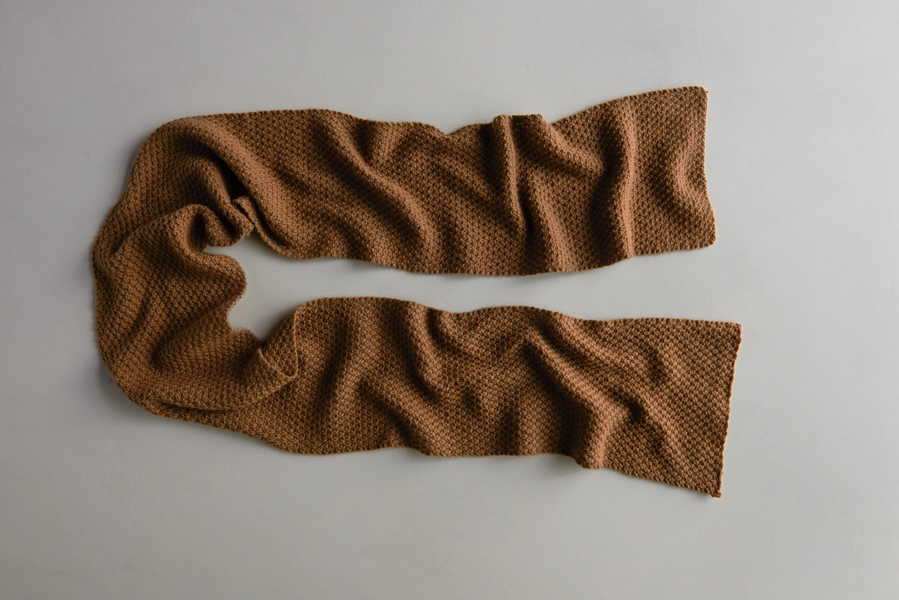

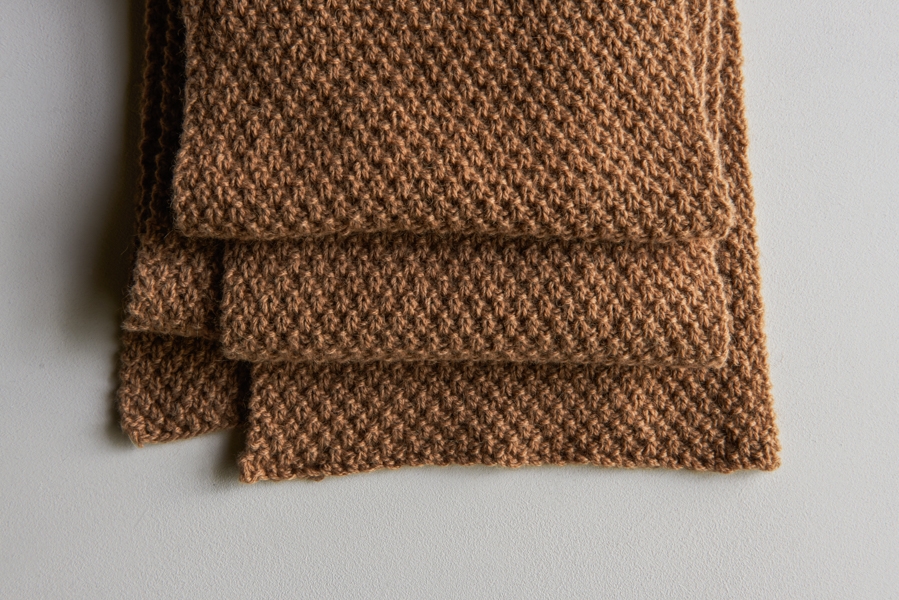
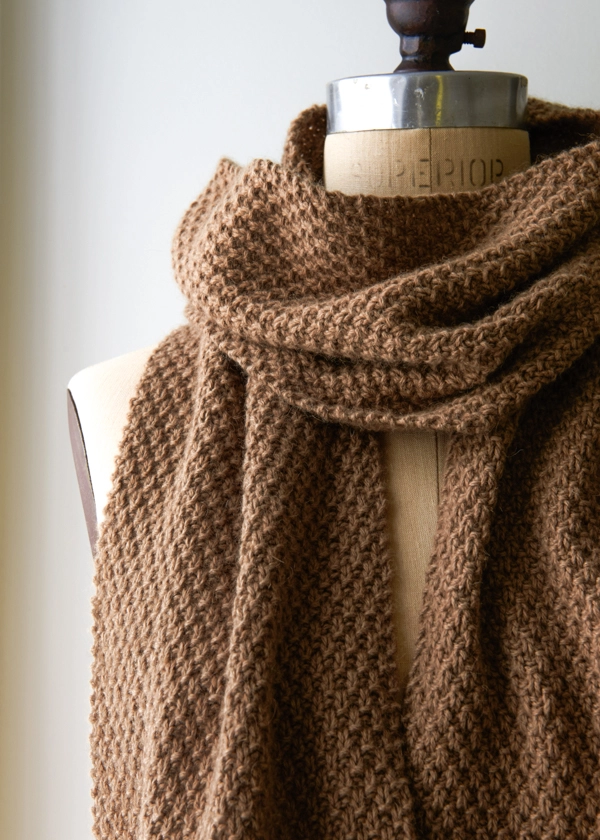


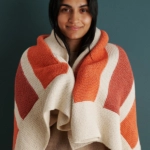
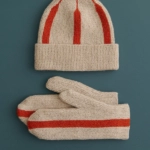

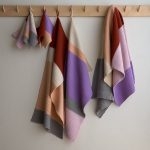
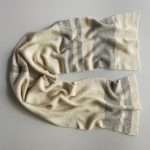
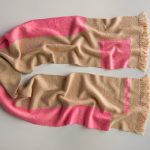
How do you think this scarf will look if knitted with your understory yarn?
Thank you, Sheryl
Hi Sheryl,
Thanks for writing in! I think that this scarf would be lovely using Understory! Due to the larger yardage, you will just 3 skeins!
Happy knitting!
Cassy
I would like to make this scarf, but shorter.
How long would it be if I use only 4 skeins of the camel hair?
Thanks.
Marion
Hi Marion,
Thanks for writing in! Using 4 balls of the Camel yarn would yield, roughly a 60 inch long scarf!
I hope that this helps!
Cassy
What if I am making a blanket that calls for 160 stitches and want to do this stitch as the border? I have tried the seed stitch countless times using, to the letter, different knitters’ instructions, and always do it wrong. I am getting a bit frustrated, but still really like this stitch. I don’t really understand how it works (yes, knit the purls and purl the knits, but that doesn’t work and it doesn’t coincide with a lot of the instructions I’m reading or watching). Please help! This is a lovely scarf, by the way.
Hi Katie,
Thanks for writing in! This pattern here is a Double Seed which is different than a Seed stitch. The Double Seed is a 4 row repeat whereas Seed is a 1 or 2 row repeat depending on how many stitches you are working. Adding a seed stitch border is a bit easier than a double seed stitch border.
To add a seed stitch border, add an even number of stitches for each side and then work a repeat of k1, p1 on the right side and p1, k1 on the wrong side.
To add a double seed stitch border, add 5 stitches to each side (you can add more by adding sets of 2 stitches) and then:
Row 1: K1, *p1, k1, repeat from * to end of border, follow pattern for blanket, K1, *p1, k1, repeat from * to end of border.
Row 2: Repeat Row 1.
Row 3: K2, *p1, k1 repeat from * to last stitch of border, k1, follow pattern for blanket, K2, *p1, k1 repeat from * to last stitch of border, k1.
Row 4: Repeat Row 3
I hope that this helps!
Cassy
Bei lavori
Bravi
Grazie
Which bind off technique do you usually use? I find my bind offs are usually too tight and often curl.
Thanks in advance.
Hello Jenn,
Thank you for reaching out! I almost always use The Basic Bin Off for my projects. I have found that the key to a nice bind off is keeping your bind off nice and loose.
I hope this helps!
Warmly,
Marilla
Hi,
I am considering knitting this scarf. Unfortunately the recommended yarn is sold out. Blue Sky Sport Melange was recommended in a previous post. A) Is this a good replacement yarn? B) If so, how much yarn is required? C) What size needles?
Thanks for your help and I love all of your patterns.
Tonia
Hi Tonia,
Thanks for writing in! You can make this lovely scarf out of a lot of different options!
You can certainly use Blue Sky Sport! It is a bit thinner than the yarn that we used and as such you may want to go down to a US 5 needle. You will also need to knit a gauge swatch in pattern to determine your cast on number. Once you know your stitches per inch, you will want to multiple it by 9 1/2. This pattern will work over any multiple of 2 + 1 stitch, so you will want to select the closest number. To get a scarf of equal length, I think that you will need 7-8 skeins of Blue Sky Sport.
Alternately, you could use 3 skeins of Understory or 4 skeins of Flax Down or 5 skeins of Woolfolk Far.
I hope that this helps!
Cassy
Thanks for your suggestions. The pattern/needle size would be as written if I went with one of these?
Hi Tonia,
If you went with one of the suggestions other than the Blue Sky Sport, you can work the pattern as written with the same needles! As always when substituting yarn, you may want to knit a gauge swatch as small differences in yarn and personal gauge can effect the final size. You can always change your needle size to compensate for this.
I hope that this helps!
Cassy
Could I make this in one of your cashmere’s? Would it have the same textured effect?
Hi Jill,
Thanks for writing in! I think using cashmere for this scarf is a fantastic idea – it will show the stitch definition just as well and be absolutely luxurious! Our Jade Sapphire Zageo 6-Ply Cashmere would be the correct weight to substitute in this pattern, and you would still need 5 skeins for the same size scarf.
Best of luck and happy knitting!
Julianna
Would US 8 still be the ideal/recommended needle size if using the Jade Sapphire Zageo 6-Ply Cashmere for this project?
Many thanks,
Jordan
Hi Jordan,
Great question! Although it’s always a good idea to knit a gauge swatch when substituting yarns, Jade Sapphire Zageo 6-Ply Cashmere is the same weight as Lanecardate Camel, so a US 8 will most likely result in the correct gauge.
Best,
Julianna
I want to knit this scarf with your 8ply cashmere in color Slate Blue 039. How many skeins needed?
Hello Monique,
Thank you for writing us! This scarf will be exquisite in Jade Sapphire’s Slate Blue. You will need 7 skeins of the 8ply to complete this project.
Happy knitting!
-Marilla
Hi thanks for sharing the pattern. I would like to check with you for row 3, does it mean the 44th and 45th stitches are both knit stitches?
Hi Claris,
Thanks for writing in! You are correct, you will be knitting the last two stitches of this row!
Best of luck and happy knitting!
Julianna
Hello,
I have leftover cattick silk left from my last project. Can I use it for this pattern?
Thanks
Hi Ginny,
Thanks for reaching out! Unfortunately, the Double Seed Stitch Scarf is written for a much thicker yarn than Cattail Silk. It may work if you hold the yarn doubled, but I would definitely recommend knitting a gauge swatch to see if it will turn out to the correct gauge and size. If not, you may be interested in our Rose Stitch Scarf, which is written for Cattail Silk and has a similar textured stitch.
I hope that helps!
Julianna
With rows 3 and 4 the last stitch is a purl. How did I add the k1 ? Do I make the last tweet stitches k, like the first two stitches ?
Hi Kartika,
Thanks for reaching out! When working rows 3 and 4, you should be repeating *p1, k1* until you have one stitch remaining and then knit the final stitch, so yes, you will have two knits in a row at the end of each of these rows.
I hope that clears things up!
Julianna
Hello, is there a hat pattern that matches this scarf? I’m in love with this pattern and would love to make a hat and scarf set!
Hello Grace,
Thank you for reaching out! We don’t have a seed stitch hat pattern, but I think that our Four Spokes Hat would be a lovely companion to this scarf.
Happy knitting!
-Marilla
Hello
I’m wondering if you’re able to provide instructions for making this an infinity scarf?
Thanks
Natasha
Hello Natasha,
Thank you for reaching out! The easiest way to achieve this would be to simply seam the two ends together. You would just knit your scarf until it is your desired length and then just seam the ends together.
Happy knitting!
-Marilla
Hello,
I’m a true beginner and I have a basic question:
What is the difference between K1 and k1? Does the capital mean the beginning of the row?
Also does K1 mean knit one stitch and K2 mean knit two stitches?
Thank you for clearing the fog!
Hi Medina,
Thanks for reaching out, and I hope you are enjoying knitting so far! The capitalization is only used when it is the first letter of the line or sentence and doesn’t mean to knit anything differently. If a pattern just says k1 and k2, yes, that does just mean to knit one stitch or knit two stitches!
Best of luck and happy knitting!
Julianna
What other scarf from your website can I use the 6 skeins of camel for a scarf for my husband?
Hi Susan,
Thanks for reaching out! Any scarf written for a worsted weight yarn should work well with Lanecardate Camel. A few options with different stitch patterns would be our Seedbed Scarf, Rick Rack Scarf, or No-Purl Ribbed Scarf. You can view all of our worsted weight scarves by clicking here!
I hope that helps!
Julianna
I thought that this yarn, which I have already purchased, is a DK weight. It this incorrect? I am not a fan of seed stitch, and I have been looking for patterns for a cowl using no more than 3 skeins.
Would it possible answer my question, and also to suggest other patterns for it?
Many thanks.
Hi Barbara,
Thanks for reaching out! Yes, the LANECARDATE Camel yarn used in the pattern is a light worsted/dk weight! We have some wonderful patterns available for light worsted/dk weight Cowls and you can find them all Here! For example our Wild Grass Cowl is a beautiful pattern and we only used 299 yards so 3 skeins would be plenty!
I hope this helps and please feel free to reach out with any more questions!
Warmly,
Gianna
Do you think this yarn could be dyed dark brown?
Hi Angela,
Thanks for reaching out! If you are familiar with acid dyes, which are commonly used for at-home yarn dyeing, they will work fantastically well on any protein or animal fiber, including camel, and going from a medium brown to a dark brown shouldn’t present any issues.
Best,
Julianna
Hello,
I’m trying to make this scarf with the Camel yarn. I’m finding the Camel yarn to be difficult to work with. It keeps unravelling and the yarn keeps breaking. I keep needing to tie it together to be continuous so there are a lot of ties and loose ends you can see in the scarf itself. I bought three balls of the Camel yarn in the New York store and two of them have been entirely like that. The third ball wasn’t as wispy and held up pretty well to be consistent.
Please let me know if you’ve experienced this or if I should go to customer service with this.
Thank you,
Surabhi
Hi Surabhi,
I’m so sorry to hear that you are experiencing these problems with the Camel yarn! This sounds quite unusual (and upsetting!), so please do contact us at customerservice@purlsoho.com with the dye lot number so we can look into this further.
Best,
Julianna
Five balls of this yarn seems like a lot of yardage; does anyone know how much of the fifth ball is actually used if the scarf is 9.5 x 78″? Would four be sufficient without reducing the size too much? 9.5 x 78″ seems particularly wide and long to begin with. And how many balls of yarn would one need for a scarf about half the size of the original 9.5 x 78″?
Hi Mary,
Thanks for writing in! We used almost all of the 5 skeins of camel. Our estimate on the total yardage is roughly 680 yards. With scarves ranging from roughly 6 to 14 inches wide, we like the medium width that gives a bit more cushieness here but you can certainly make it narrower if you prefer a thinner scarf!
If you would like to make a version that is just 4 3/4 inches wide, you will wide about 2 and a half balls. With 3 balls, you could get a scarf that is about 5 to 5 1/2 inches wide!
I hope that this helps!
Cassy
If I choose to knit this lovely scarf with your sport weight, what size needles do you suggest?
Also, my measurements are 15″ x 70″ and will cast on about 69 stitches. How many skeins should I purchase?
Thanks!
Hello Julie,
Thank you for reaching out! Which sport weight yarn are you using? Your cast on will be determined by your gauge or how many stitches per inch you are getting. For example If you were using our Season Alpaca and were getting 6 stitches per inch you would cast on 91 stitches to get a scarf that is 15 inches wide. This is because 6×15 = 90, but for this stitch pattern you need an odd number so you will cast on 91 stitches.
I hope this helps and happy knitting!
-Marilla
I love seed stitch wieght patterns. I have about 430 yds of a fingering weight yarnI’d like to use for this scarf. Should I still cast on 45 stitches? Thanks for your help.
Hi Rosemary,
Thanks for reaching out! Since the Camel yarn is more of a DK or light worsted weight yarn, you could use a fingering weight yarn held double to follow the pattern as written, but you would need quite a bit more yardage. For a similar size scarf with he yarn held double, you would need about 1200 yards. You could use your yarn without doubling it, but that still isn’t very much yardage for a fingering weight scarf unfortunately. Most fingering weight scarves or wraps do take around 900 to 1200 yards, so you might want to consider something like a short cowl or hat for your yarn.
I hope that helps!
Julianna
I would like to know if there is a hat pattern to match this beautiful scarf?
Hi Dorothy,
Thanks for writing in! Unfortunately we do not have a hat pattern that exactly matches this scarf, but I will be sure to pass your request along to the design team. You may be interested in our Fluffy Brioche Hat which has a similar texture, although it is not quite the same stitch.
I hope that helps!
Julianna
Hello – Would your worsted twist yarn be a good yarn for this scarf? If so, how many skeins would I need?
Hello Brooke,
Thank you for reaching out! This pattern would work beautifully with Worsted Twist.
Happy knitting!
-Marilla
Hi,
I hope you are doing well. I would like to do the double stitch scarf in serpentina. I would like to knit it a little bit wider. If I buy another skein how many stitches I would have to add to have the scarf a little wider?
Thanks for your help
Suzanne
Hi Suzanne,
Thanks for writing in! If you cast on 57 stitches, you should be able to make your scarf just as long as ours and use up your extra skein of yarn quite efficiently!
I hope that helps, and happy knitting!
Julianna
Hi there,
This is such a beautiful pattern. If I wanted to knit a scarf that was 8″ wide instead of 9 1/2″, using a chunky yarn, how many stitches would I have to cast on?
Thank you so much for your help.
Hi Ally,
Thanks for reaching out! Since your yarn is quite different from ours, I would recommend knitting a gauge swatch in the Double Seed Stitch pattern on a needle that is recommended for your yarn. You can then multiply your stitches per inch by 9.5 and round to the nearest odd number to determine how many stitches to cast on.
Happy knitting!
Julianna
I made this scarf using merino wool yarn on size 8 needles. I have more yarn and would like to make a hat. I like your Four Spokes hat, but it has different yarn with size 3 needles. Any suggestions?
Hi Charlotte,
Thanks for writing in! We used a light worsted or DK weight yarn for our scarf, which would be too heavy for the Four Spokes Hat. If you also used a DK weight yarn, I would suggest our Fluffy Brioche Hat or Heel Stitch Hat to coordinate with the scarf!
Best,
Julianna
I would like to use Understory and make a wrap that is about 18-20 inches wide and 72 inches long. How many stitches do I need and how much yarn ? thank you
Hello Janice,
Thank you for reaching out! With a gauge of 19 stitches per 4 inches in stitch pattern you can get a width of 19″ with a cast on of 91 stitches. You can then just knit until you reach 72″. To make a wrap this size you will need 6 skeins of Understory.
I hope this helps and happy knitting!
-Marilla
Im sorry im finding it hard to understand this pattern. I’m new to knitting and I would really love to do this one.
I can’t understand what * means
I’ve just been doing K1, P1 for each row but its not looking right
Hi Kashmira,
Thanks for reaching out, and I’m happy to explain! An asterisk in a knitting pattern indicates a repeat – so, for Row 1 of this pattern, which reads “K1, *p1, k1, repeat from * to end of row,” you will knit 1 stitch, then repeat “purl 1, knit 1” until you get to the end of the row. Row 2 is then exactly the same as Row 1. For Row 3, which reads “K2, *p1, k1 repeat from * to last stitch, k1,” you will start by knitting 2 stitches, and then repeat “purl 1, knit 1” until you get to the last stitch of the row, which you will knit. Row 4 is a repeat of Row 3.
I hope that clears things up, and please let us know if you have any other questions!
Julianna
I am making this using Lancardate camel yarn. It is knitting up beautifully and the yarn is so nice. I am about to finish the first skein. Will a spit splice work with this yarn or do you recommend something else?
Hi Susan!
While wet splicing can be a great way to join a new ball of yarn, I wouldn’t recommend it for the Lanecardate Camel. In addition to being quite a smooth yarn, camel also doesn’t felt very well. We’d recommend joining in a new ball leaving both ends to weave in later, and we’ve got a quick tutorial here:
Thanks so much for your question – Happy Knitting!
Cassandra
Hi! I would love to knit this scarf but the yarn is sold out. Could you give a recommendation for a similar yarn that’s in stock? If needle size changes or I need a different amount of yarn please let me know that as well. Thank you in advance!!
Hi Sydney,
Thanks for reaching out! The Camel yarn that this scarf if knit with is a light worsted/dk weight so I would recommend Understory or Good Wool! You will either need 3 skeins of Understory or 2 Skeins of Good Wool and I also recommend working a gauge swatch in whichever yarn you choose with the recommended US 8 needle to see if it is consistent with the pattern or if you will need to adjust the needle size from there!
Please let us know how this works out, happy knitting!
Gianna
I’m knitting this scarf in Understory but I want to get this camel yarn for another scarf. Which pattern would you recommend would work well with the camel? How much would I need and what size needle?
Thanks
Hi Ellen,
Thanks for reaching out! The LANECARDATE Camel is a dk/light worsted weight so any of our pattern for that weight of yarn would work! You can find all of our scarves and wrap patterns for light worsted/dk weight here! In particular for Camel, I would recommend the Trellis Wrap (4 skeins of Camel for the scarf size), Mini Herringbone Scarf (6 skeins of Camel), Braided Rib Wrap (8 skeins of Camel), and the Daybreak Scarf (10 skeins of Camel)! For each of these you could use the recommended needle size that is written in the pattern, but I do recommend working a gauge swatch to insure your gauge is consistent!
I hope this helps, happy knitting!
Gianna
HI! I’m very confused by the instructions—are they for knitting in the round? I’m using straight needles. What is the intended effect? Seed stitch doubled vertically?
Margaret
Hi Margaret,
Thanks for reaching out! This pattern is worked flat, not in the round and the pattern is written to be worked on circular or straight needles! This is a double seep stitch pattern that is worked vertically up the scarf, you start the first row by K1, *p1, k1, repeat from * to end of row and repeating that for the 2nd row to get the double seed, then for rows 3 + 4 you are K2, *p1, k1 repeat from * to last stitch, k1.
I hope this clarifies things!
Warmly,
Gianna
Hi
What if i want to make it wider
With how many cast on stitch should i start ?
Is there arole amultiple of a number or any number i want ?
Hi Mai,
Thanks for reaching out! This pattern works over an odd multiple of stitches. If your gauge is consistent with the pattern you can easily calculate your cast on number from there. For example if you wanted a 12″ scarf I would recommend casting on 57 stitches, or for a 15″ scarf I would recommend casting on 71 stitches. I recommend checking out our All About Gauge tutorial, it is a great resource to use.
I hope this helps, happy knitting!
Gianna
Hello:)
I love this pattern and had saved it on my pinterest board to knit for a friend . I bought some beautiful merino/ camel hair yarn but it is aran weight (worsted?) It calls for american size 7/4.5mm needles, and I am wanting to knit the scarf 6 inches wide. Please don’t ask me to knit a swatch:) Could you tell me approximately how many stiches to cast on? And thank you for sharing such a beautiful pattern. Kindest regards:)
Hi Lynda,
Thanks for reaching out! I understand you don’t want to make a swatch but unfortunately that is a crucial step whenever altering a pattern and the only way to get an accurate measurement for your cast on, especially since you are using a different yarn and needle size than what we recommend here! I can’t suggest an accurate cast on without knowing your gauge, however if it is close to the gauge of this pattern I would suggest casting on approximately 29 stitches for 6″.
I hope this helps, happy knitting!
Gianna
I want to make this, but it seems like there is a mistake in the pattern. With an uneven number of stitches, repeating Row 1 would create a single moss stitch instead of double. Please correct me if I’m wrong.
Hi Marla,
Thanks for writing in. The pattern actually begins on the second row of the double seed stitch pattern! The combination of Rows 2 and 3 (and of Rows 4 and 1) create the doubled effect. Hope this helps explain things!
All the best,
Lili
Thank you for the clarification! I should have made a swatch instead of trying to figure it out be reading the pattern over and over! I am going to make this beautiful scarf for my next project.
Hello, I am a beginning knitter, I bought your learn to knit kit, and two extra skeins of the super soft merino wool. Would this pattern work with that wool? I would like the scarf to be roughly 10 inches wide. Would I cast on 25 stitches? Thank you for your help!
Hi SP,
Thanks for reaching out. This pattern will definitely work with Super Soft Merino! To figure out your cast-on number, you will want to first knit a gauge swatch in pattern (if this is daunting, feel free to visit our tutorial, All About Gauge). Once you know how many stitches you are getting per inch, you can multiply that number by 10 inches and cast on the nearest odd number. Hope this helps!
All the best,
Lili
Hii, hope you’re having a lovely day!
I want to make this pattern with some vertical stripes so i thought it might be simpler to knit the scarf sideways but i’m having trouble figuring out what the pattern would be in that case, is it even possible to turn this pattern sideways? I’m kind of a beginner so i’m sorry if there’s an obvious answer to this 😅😅
Thanks in advance!
Hi Masey!
Thank you for your question! To cast on this scarf on the long edge, all you would need to do is use your gauge measurement to figure out how many stitches to cast on. Assuming you are knitting at gauge, you would need to cast on 371 stitches for a 78″ long scarf. Then, you can follow the pattern as is for the rest of the scarf until it is your desired width! For a striped variation, I would suggest always joining a new color on the same side, so that your seams are consistent.
I hope this helps with your project planning!
All the best,
Margaret
I am a fan of slipping the first stitch for a neater edge. To do that with this pattern, should I just slip, or add 2 stitches (edge on each side) and then follow the stitch pattern? TIA!
Hi Nancy,
Thanks for writing in! I’d recommend adding two extra stitches, to be sure that it doesn’t disrupt the stitch pattern. Hope this helps, and let us know how it turns out!
All the best,
Lili
I would like to knit this scarf but I’m not sure what wool to use. I hope u can help me. I live in Ontario Canada so what kind of yarn would I use and the size of needles. Thanks very much.
Hi Darla,
Thanks for reaching out. We used a light worsted/DK weight yarn for this pattern, so any most other yarns of the same weight would work as well! If you’d like to take a look at the DK weight yarns we currently carry, just check out this page.
We used size US 8 (5mm) needles to knit this scarf, but the actual needles you use will depend on your tension as a knitter! We always recommend knitting a gauge swatch before casting on your project, especially when you are substituting yarns. You may need to size up or down your needles in order to get the correct gauge! If you would like to learn more about this, we have a handy tutorial called All About Gauge, which you can find right here.
I hope this helps!
All the best,
Lili
Can you make this scarf in Lovebird? If so, how many skeins do you think I would need?
Thank you.😊
Hi Brenda,
Thanks for reaching out! You would probably need about 5 skeins of Lovebird to make a good-sized scarf. Since this pattern was designed for a thinner yarn, you will also need to adjust the cast-on number so that the scarf comes to the correct width.
To figure out your cast-on number, you will want to first knit a gauge swatch in pattern. Once you know how many stitches you are getting per inch, you can multiply that number by the width that you would like and cast on the nearest odd number. Then you can follow the pattern as written!
All the best,
Lili